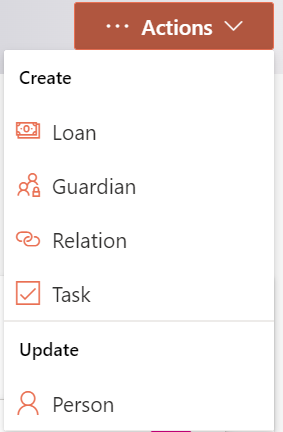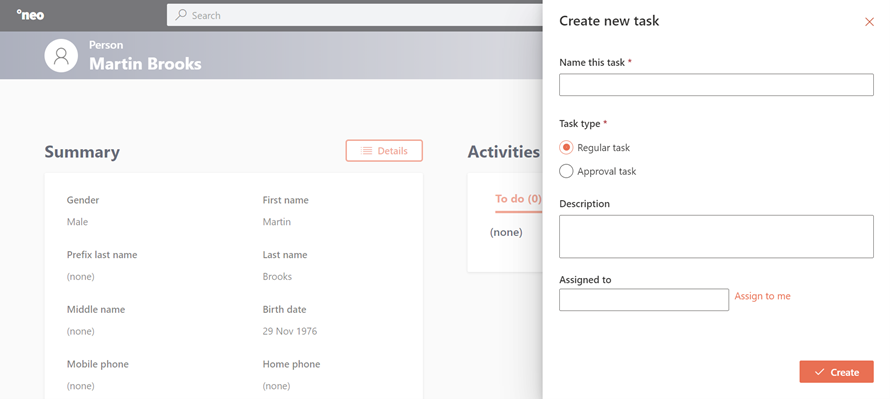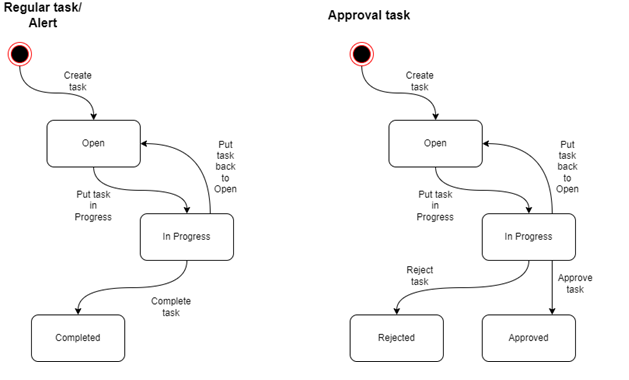Task management
Introduction
When you execute various entity related processes (e.g., update person details, register loan payment) an approval task might be created. These approval tasks indicate the additional actions or approvals that are required prior to the completion of the process, and therefore must be displayed to the employees. Next to tasks generated from a process a user can create standalone manual tasks, for instance to request a colleague to perform a certain for a client. You should be aware of the task status, execution process, and various other features which are described below.
Note: not all processes will result in a manual task. Processes that are set up to be completed automatically by the system will not require any manual intervention, therefore tasks will not be displayed in the portal.
Manual tasks
Within the Akkuro platform, you can create manual tasks. Manual tasks can be created on a person level and / or company level. To create a manual task you navigate to a person or company and open the action menu and select ‘Task’.

When you select the 'Task' action, a side pane is opened:

In below overview is described how the fields should be filled. Once the mandatory fields are filled, you can click on create and the Task is created.
| Field | Description |
|---|---|
| Name this task | Here a user should fill the name of the created task. |
| Task type | A user can select ‘Regular task’ and ‘Approval task’. The selected task type determines the task sequence. For more information see ‘Task sequence & status’ chapter. |
| Description | Here a user can enter a description of the manual task. |
| Assigned to | The user to whom the task will be assigned |
Alerts
Next to Tasks that are originated from a Process and the ones that are manually created, there is 3rd type called Alerts. Alerts are raised by the system from Processes, the moment something goes wrong . For more background on the mechanism behind this error mechanism Long running operations . The purpose of the Alert is to inform you that something unexpected happened and a follow is needed.
Task sequence & status
As described above, a task can originate from a process(as an approval task or an alert) or can be created manually. Tasks originating from a process are ‘Approval tasks’ or ‘Alerts’ . Manually created tasks can be either ‘Regular tasks’ or ‘Approval tasks’. Approval tasks are used where a user needs to approve an action that was conducted in the portal. A common example of an approval task is a 4-eyes task, where a different user than the one that initiated the change must approve the task.
A regular task and alerts are not used for approval but is used to assign tasks of work to other users. Regular tasks/Alerts and Approval tasks have a different sequence, below picture shows the sequence for each task types:

The statuses have the following meaning:
| Status | Description |
|---|---|
| To do | Task is created but not yet picked up by anyone. |
| In Progress | Task is picked up and someone is working on it. |
| Approved | Task is finished and has been approved. |
| Rejected | Task is finished and has been rejected. |
| Completed | Task is finished and has been completed. |
Task attributes & features
Tasks are displayed in different locations across the portal – it can be shown on the KanBan dashboard task list, or on the entity profile in a Single view. When a task is opened in a Single view it is displayed in a side pane as shown below:

In the first line the name of the Task is displayed and on the second line the related entities (can be multiple) are displayed. On the left side of the screen (behind the task) the entity (e.g., person or loan) that the task is related to is displayed. When the task is not related, the task is opened on top of the Dashboard. On the right side of the screen, a sidebar with the task is displayed.
Depending on the type, the task will have two or three tabs. Tasks resulting from the creation of a new person or product will generally have two tabs – ‘about the approval’, and ‘comments and changes’. Tasks resulting from a change or update of a person or product will have an additional third tab that displays the content of the change. Alert task generally have 2 tabs ‘about the alert’ and ‘comment and changes’. The content of these tabs is described in further detail below.
To approve
When the task relates to a change/update of a person or product, this tab will display the content that was updated and requires approval.
About the approval/About the alert
On this tab you can change the status of the task. Depending on the current status of the task, the primary action (bottom left button) differs. When the task status is 'To do' the primary action is 'Start doing', and when the task status is 'In Progress' the primary action is 'Approve' or 'Complete'. Secondary actions are displayed right of the primary action.
You can assign a task to a specific individual or user group by either selecting a user from the list after clicking 'Edit', or by clicking 'Assign to me'.
The last part of this tab is the Description. The Description can be either filled manually on creation or for Alerts the Description is filled with an error message with the reason the Alert is raised.
Comments and changes
On this tab you can see the task history and create/view comments on the task. The task history will display all the comments, assignment and status changes, and by typing in the comment textbox and clicking 'Save comment', you can post your own comment on the task.
Updated 10 days ago